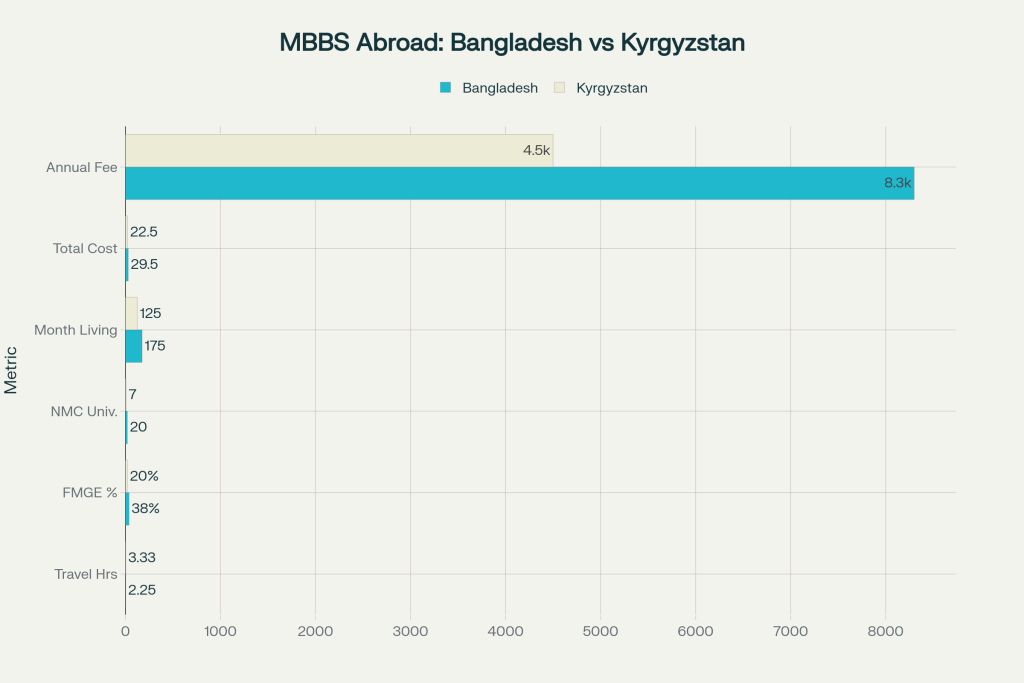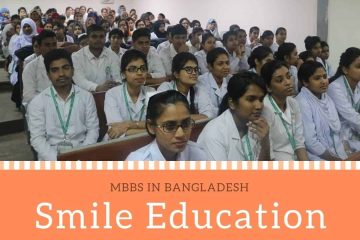Find Compare MBBS in Bangladesh vs MBBS in Kyrgyzstan
MBBS Education Comparison: Bangladesh vs Kyrgyzstan
For Indian students seeking affordable medical education abroad, both Bangladesh and Kyrgyzstan have emerged as popular destinations. This comprehensive comparative study examines key factors to help prospective medical students make an informed decision between these two countries.

Detailed comparison table of MBBS education parameters between Bangladesh and Kyrgyzstan
Course Structure and Duration
Both Bangladesh and Kyrgyzstan offer 6-year MBBS programs structured as 5 years of academic study plus 1 year of mandatory internship. The curriculum in both countries follows international standards and is designed to prepare students for global medical practice.
Bangladesh follows a semester system with 6-month intervals between semesters. The course is divided into three phases: Pre-Clinical, Para-Clinical, and Clinical, with modern teaching aids including multimedia and models incorporated into classes.
Kyrgyzstan similarly offers a 6-year program with 5 years of classroom training and 1 year of internship training. The curriculum combines theoretical knowledge with practical skills, emphasizing clinical exposure from the second year onwards.
Cost Comparison
Tuition Fees
Bangladesh offers more expensive medical education with annual tuition fees ranging from $6,600 to $10,000 (₹5.5 to 8.4 lakhs). The total course cost ranges from ₹24 to 35 lakhs for the complete 6-year program.
Kyrgyzstan provides significantly more affordable medical education with annual tuition fees ranging from $3,000 to $6,000 (₹2.5 to 5 lakhs). The total course cost ranges from ₹15 to 30 lakhs for the complete program.
Living Expenses
Bangladesh has monthly living costs of $150-200 (₹12,000-16,000), while Kyrgyzstan offers lower living costs of $100-150 (₹8,000-12,000) per month.
Hostel Accommodation
Bangladesh hostel fees range from $1,500-2,000 annually, whereas Kyrgyzstan offers more affordable hostel accommodation at $500-650 per year.
Eligibility and Admission Requirements
Academic Requirements
Bangladesh requires higher academic performance with 60% marks in Physics, Chemistry, and Biology (PCB) for general category students and 50% for reserved categories. Students must also qualify NEET with the minimum required score.
Kyrgyzstan has more relaxed eligibility criteria, requiring 50% marks in PCB for general category students and 40% for reserved categories. NEET qualification is mandatory but no specific score requirement is mentioned.
Age and Other Requirements
Both countries require students to be at least 17 years old by December 31st of the admission year. Neither country requires IELTS/TOEFL scores, as programs are conducted in English.
Recognition and Accreditation
Both countries offer globally recognized medical degrees approved by major international bodies:
Bangladesh medical universities are recognized by NMC (National Medical Commission), WHO, BMDC (Bangladesh Medical and Dental Council), and ECFMG. The country has 20+ NMC-approved medical universities.
Kyrgyzstan medical universities are recognized by NMC, WHO, FAIMER, ECFMG, and the Ministry of Education, Kyrgyzstan. The country has 6-9 NMC-approved medical universities.
Top Universities
Bangladesh Top Medical Colleges
| University | Location | Total Fee (US$) |
| Dhaka National Medical College | Dhaka | 48,000 |
| Bangladesh Medical College | Dhaka | 49,000 |
| Southers Medical College | Chittagong | 41,000 |
| Community Based Medical College | Dhaka | 45,000 |
| Eastern Medical College | Cummila | 43,000 |
Kyrgyzstan Top Medical Universities
| University | Location | Total Fee (USD) |
| Kyrgyz State Medical Academy | Bishkek | 35,000 |
| Osh State University | Osh | 38,000 |
| International School of Medicine | Bishkek | 36,000 |
| Jalal-Abad State University | Jalal-Abad | 34,000 |
| Issyk-Kul State University (IKSU) | Karakol | 30,000 |
Academic Quality and Student Support
Bangladesh offers excellent academic facilities with experienced faculty and a student-teacher ratio of 2:16 in some colleges. The country provides extensive clinical training in affiliated hospitals with high-quality infrastructure.
Kyrgyzstan maintains a favorable student-teacher ratio of 10:1 or better, allowing for more personalized attention. Universities offer modern infrastructure with state-of-the-art facilities and advanced research opportunities.
FMGE Pass Rates and Career Prospects
Bangladesh shows a higher FMGE pass rate of approximately 38% for Indian students, indicating better preparation for Indian medical licensing examinations. The country has produced thousands of successful doctors practicing in India and abroad.
Kyrgyzstan has an FMGE pass rate of approximately 20%, though many graduates successfully clear international licensing exams like USMLE and PLAB.
Cultural and Practical Considerations
Cultural Similarity
Bangladesh offers very high cultural similarity for Indian students, with similar food habits, climate, and traditions. Students often feel comfortable due to the cultural affinity between the two countries.
Kyrgyzstan provides a moderate cultural environment with different traditions and customs. However, universities provide Indian food in hostels and support services for international students.
Travel and Accessibility
Bangladesh is more accessible with a travel time of 2 hours 15 minutes from India. The visa process is simple for Indian students.
Kyrgyzstan requires 3 hours 20 minutes travel time from Delhi to Bishkek. The visa process is moderately complex but manageable.
Language and Communication
Both countries offer medical education in English medium, eliminating language barriers for Indian students. However, Kyrgyzstan also offers programs in Russian for students who prefer that option.
Practical Training and Clinical Exposure
Bangladesh provides extensive clinical training in affiliated hospitals with exposure to complex cases and modern medical equipment. Students gain hands-on experience in large teaching hospitals.
Kyrgyzstan offers clinical exposure from the second year onwards with practical training in modern medical facilities. Universities maintain partnerships with hospitals for comprehensive clinical experience.
Conclusion and Recommendations
Choose Bangladesh if:
- You prefer higher academic standards and cultural similarity
- Budget allows for higher fees (₹29-45 lakhs total)
- You want better FMGE pass rates (38%)
- You prefer shorter travel time and an easier visa process
Choose Kyrgyzstan if:
- You seek more affordable medical education (₹25-40 lakhs total)
- You prefer lower eligibility requirements (50% in 12th)
- You want better student-teacher ratios (10:1)
- Budget is a primary concern
Both countries offer quality medical education with international recognition. Bangladesh provides a more expensive but culturally familiar environment with higher pass rates, while Kyrgyzstan offers a more budget-friendly option with excellent academic infrastructure. The choice ultimately depends on individual priorities, budget constraints, and personal preferences regarding cultural adaptation and academic requirements.

Comprehensive comparison infographic of MBBS education between Bangladesh and Kyrgyzstan, showing costs, recognition, and key factors
⁂
- https://www.mbbsinbangladesh.in/eligibility-criteria/
- https://www.smileeducation.in/eligibility/
- https://en.wikipedia.org/wiki/List_of_medical_colleges_in_Bangladesh
- https://www.mbbsinbangladesh.in/medical-education-bangladesh/
- https://www.mbbsbangladesh.com/admission-process/eligibility/
- https://www.directmbbsadmission.com/bangladesh-medical-college-ranking/


